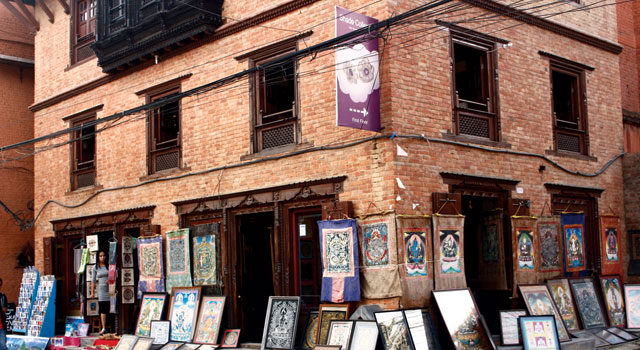An expatriate experiences life in a close community amidst the hustle and bustle of Patan
To an outsider, the streets and alleyways of Kathmandu and its neighboring towns can seem chaotic and completely inconvenient. If you spend enough time in the courtyards and squares (and with the people who call them home), and follow the path led by those who came before you, you’ll slowly but surely see that there is logic in the chaos.

When I arrived in Nepal, I learned that how ants came to our kitchen in the first place was more interesting than how we got rid of them. Leave the smallest crumb of food in even the most pristine Nepali home, and within a matter of minutes, ants will appear. First one arrives. Then a second one follows the first’s trail. Twenty others follow suit, until finally they are streaming together from all directions to form a mob. They are an army with an endgame: the scraps of your last meal. Sweep away the crumbs, and they retreat. The amoeba disappears in streaks of orange. But the way they finally come together is actually completely random. It is true that the second ant follows the first ant’s scent, but it has no way of knowing whether the first actually found the meal that they’re all looking for. They stumble upon one another as they look for the same place, try to fulfill the same need. One ant follows another, the scent of one another gets stronger, and the rest follow. They might not even know each other, be part of the same ant colony, but their lives converge.

I had arrived just an hour earlier at 10 pm, an ungodly hour in Nepal. After my taxi from the airport had driven through the highway where people walked along the shoulder, past the narrow streets, brick buildings, and temples in our neighborhood in Patan, I settled into the house where I would live with my friend, a filmmaker and fellow American, Tom. To mark my first night, we drank gin and tonic, ate chicken tandoori, and I let the mother cat and one of the babies into my room. They lived along the neighbouring rooftops, but preferred our four-storey balcony. We could all bond as a family; members of the same household. The kitten nestled into my open backpack, peed on my insurance paperwork, and the mother hopped into my laundry bin with a massive rat in her mouth.

I woke up the next morning to the balcony floor covered in pigeon feathers, guts, and a stream of orange ants. How the ants got there, this high up from the streets below filled with the crumbs and leftovers they should have been eating, I couldn’t understand.
Tom had been living in Nepal for two months, working on a film. On foot he guided me through the same streets that just the night before were pitch black and empty, besides the stray dogs who howled at anything that moved and interrupted the still night. Now in the morning, the streets were swarming with people, cars, and motorcycles, ripping and weaving past one another, honking or yelling at every turn. Without sidewalks, I tried to follow the flow of the traffic, but constantly bumped shoulders, tripped over bricks and puddles, and flinched at every honk that seemed reserved solely for me, the lowly tourist who moved in a way unbefitting to the streets of Patan and Kathmandu. When a microbus clipped my arm and half a dozen men popped their heads out of the window to laugh at the poor American girl rubbing the spot where a bruise would later form, I was sure that there was absolutely no order to this place. Just walking down the street meant entering a world of chaos.
I missed home. In New York I learned that the city has a rhythm. If you know the rhythm, feel it in your body, you can find whatever you need. But a city like New York runs on anonymity. People never meet their neighbors. They go to work and make professional connections, but they care little about the spaces between work and home, where the guy who lives next door passes them in a corridor and they either smile, say hello, or walk past without acknowledgement.
At the end of that first day, we returned exhausted and nerve-racked to the house, but just before entering the door that led to the courtyard, the local shop owners and their friends stopped us. They regularly sat on stools and steps outside our door, and now they were curious about the new expatriate making a home in their square. We would learn that Swotha was truly their square. They had a right to know who was moving into it, and to serve them coffee.
In his jewelry shop across the street, the owner, a tall Newari man clad in silver rings and a perpetually half-unbuttoned shirt, dumped sugar into little cups on a marble tray. He asked me what I thought of Kathmandu. I told him, “The squares and temples are beautiful, but poorly kept. Not like this.” I gestured out the window, toward Swotha, just five minutes from Patan Darbur Square. It was much smaller, the temples and shrines were less grand, more dogs roamed around, but except for a pile of rubble tucked away behind sheets of wood, there was no litter. Anyone who dared leave anything but an offering at a shrine was given a stern look from the shop owners. They stopped traveling salesman from entering the courtyard by telling them the dogs inside would bite them.
“Most Nepalis don’t care about their courtyards or squares. We do.” He told us about the collection he and his friends were taking around the square—Every month he, his friend at the tea shop, and their friend at the wishing bowl shop, would ask for donations, whatever these Nepali families or expatriate couples could afford out of pocket to keep their square clean. It was all of theirs, after all. Each morning, they would open their doors to the square, pass each other as they walked to their scooters, and their lives would converge. At night when they came home to their separate, private homes, they still had to pass through the space where they all rang the same bell at the same shrine, where they walked across the street to buy a soda from the cold store, where Lalita didi always told them they could pay her back tomorrow when they woke up again, before they hopped on their scooters and left. She trusted them. They would make it up to her when they saw her again.
How any of the people who lived around the square got there in the first place was anyone’s guess. There was the mother of the building’s architect, who pressed a button from her bedroom and unlocked the door to anyone who had forgotten their key. There was the Danish couple who had been living there for years and were just beginning their departure to Laos. We joined the mix as the Americans, writing and making films about a country we would leave in just a few months. There was also the other French couple—the woman ran the local guesthouse, and the man did graphic design. They had other expatriate guests from the hotel coming in and out for a drink or chat, and sometimes they would run into the Nepali families who spoke no English and greeted them with a curious smile. The women would sit in the courtyard and knit, shuck corn, wash clothes, or just chat. Strangers would walk through the outer gate and into this space that was both inside but still outside, the women would look up curiously, look back down to their knitting or their corn, and the strangers would have a look around then leave.
But if they stayed long enough, they learned which spaces were private or public or both. They learned that if they walked long enough, followed the paces of the others who came before them, kept an eye out for the logic and let their body find a rhythm, they’d find a newspaper stand, a stupa, a café or a restaurant, and whatever else they needed.









